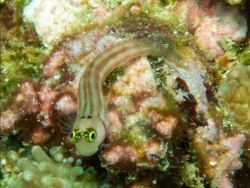Info
Ecsenius lubbocki Springer, 1988
A mostly dark species that camouflages itself well on coral. It has a series of light spots along its body and a pair of black dots on the back of its head.
Adults live singly or in pairs in algae-covered coral reefs and on flat reef surfaces with mixed rubble and coral, mostly on rock-like corals. The eggs are demersal and adhere to the substrate via a thread-like adhesive pad or base. The larvae are planktonic and are often found in shallow coastal waters.
Ecsenius lubbocki is endemic only to the waters around Thailand in shallow water up to a maximum depth of 12 m. Here, the small blenny inhabits coastal reefs, rubble zones, and zones with broken coral and heavy algae growth.
The species name “lubbocki” honors Dr. Hugh Roger Lubbock (1951–1981), an English marine biologist at the University of Cambridge.
Ecsenius lubbocki should also be easy to keep in a saltwater aquarium with a strictly herbivorous diet, but is not specifically imported.
Jumping guard
A jumping guard prevents (nocturnal) fish from jumping out.
Wrasses, blennies, hawkfishs and gobies jump out of an unprotected tank in fright if their night rest is disturbed, unfortunately these jumpers are found dried up in the morning on carpets, glass edges or later behind the tank.
https://www.korallenriff.de/en/article/1925_5_Jump_Protection_Solutions_for_Fish_in_the_Aquarium__5_Net_Covers.html
A small night light also helps, as it provides the fish with a means of orientation in the dark!
A mostly dark species that camouflages itself well on coral. It has a series of light spots along its body and a pair of black dots on the back of its head.
Adults live singly or in pairs in algae-covered coral reefs and on flat reef surfaces with mixed rubble and coral, mostly on rock-like corals. The eggs are demersal and adhere to the substrate via a thread-like adhesive pad or base. The larvae are planktonic and are often found in shallow coastal waters.
Ecsenius lubbocki is endemic only to the waters around Thailand in shallow water up to a maximum depth of 12 m. Here, the small blenny inhabits coastal reefs, rubble zones, and zones with broken coral and heavy algae growth.
The species name “lubbocki” honors Dr. Hugh Roger Lubbock (1951–1981), an English marine biologist at the University of Cambridge.
Ecsenius lubbocki should also be easy to keep in a saltwater aquarium with a strictly herbivorous diet, but is not specifically imported.
Jumping guard
A jumping guard prevents (nocturnal) fish from jumping out.
Wrasses, blennies, hawkfishs and gobies jump out of an unprotected tank in fright if their night rest is disturbed, unfortunately these jumpers are found dried up in the morning on carpets, glass edges or later behind the tank.
https://www.korallenriff.de/en/article/1925_5_Jump_Protection_Solutions_for_Fish_in_the_Aquarium__5_Net_Covers.html
A small night light also helps, as it provides the fish with a means of orientation in the dark!







 Richard und Mary Field, Malta
Richard und Mary Field, Malta


























































